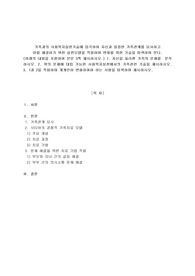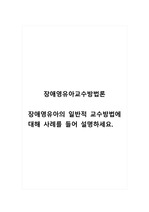

-
 * 해당 문서는 미리보기가 지원되지 않습니다. 목차와 본문을 참조 해 주시기 바랍니다.
* 해당 문서는 미리보기가 지원되지 않습니다. 목차와 본문을 참조 해 주시기 바랍니다.
미리보기
목차
Ⅰ. 서 론
Ⅱ. 기능평가와 기능분석
1. 기능 평가
1) 보고식 평가(informant assessment)
2) 기술 평가(discriptive assessment)
2. 기능 분석
Ⅲ. 기능적 의사소통훈련 모델
Ⅳ. 결 론
*참고문헌본문내용
Ⅰ. 서 론
행동장애아동의 자해, 공격 및 기타 문제행동들은 조작적 조건형성 원리(operant conditioning principles)를 이용한 치료 기법들을 통해 감소되거나 제거될 수 있다. 그러나 어떤 기법이 효과가 있을지라도, 변화된 행동이 문제행동에 기저하고 있는 동일한 목적을 달성할 수 없다면 그 효과는 단기에 그칠 뿐이다. 즉, 문제행동은 어떤 기법들을 통해 단기간에 사라지기도 하지만, 어떤 절차를 중단하자마자 다시 나타나게 된다. 어떤 행동의 기능을 고려하지 않으면, 문제행동의 억압이 불가피하게 "증상 대치" (symptom substitution)를 유발하거나 또다른 문제행동을 야기시킬 수 있다(Alberto & Troutman, 1995). 또 혐오적인 결과를 사용하여 행동을 제거할 수 있지만, 그 행동의 기능에 대한 대안 수단이 없다면 비윤리적이라고 할 수 있다(Pyles & Bailey, 1990).
기능 분석(functional analysis)은 개인의 행동에 대한 어떤 내적 동기를 파악할 수 있을 뿐 아니라 그것을 일으키고 유지시키는 환경을 정의할 때 그 행동 자체의 목적을 강조한다. 의사소통에 결함이 있는 아동이 주의를 끌기 위하여 분노발작(tantrums)을 일으키거나 읽지 못하는 학생이 당황 혹은 비웃음을 모면하기 위하여 그의 책을 던질 경우에, 그들의 목적을 달성하기 위한 다른 방법을 제공하지 않고 이런 행동들을 처벌한다는 것은 바람직하지 않다. 행동의 형태에 대해 초점을 두면 그 행동의 원인이 되는 요인들에 대한 정보를 얻지 못할 수 있다. 예를 들면, 두명의 아동이 보이는 동일한 행동이 전적으로 다른 자극에 의해 유지될 수 있다. 한 아동의 공격행동이 교사나 또래의 주의끌기 기능(정적 강화)이 될 수 있고, 또 다른 아동은 과제, 사회적 상호작용, 혹은 아동이 혐오스럽다고 생각하는 다른 사건을 회피하는 기능(부적 강화)이 될 수 있다. 어떤 한가지 치료 기법이 그런 상이한 기능을 하는 행동들에 동일한 영향을 미치지는 않는다(Iwata, Vollmer, & Zarcone, 1990).참고자료
· Alberto, P. A., & Troutman, A. C. (1995). Applied behavior analysis for teachers. New Jersey : Merrill.
· Arndorfer, R. E., & Miltenberger, R. G. (1993). Functional assessment and treatment of challenging behavior : A review with implications for early childhood, Topics in Early Childhood Special Education, 13(1), 82-105.
· Axelrod, S. (1987). Functional and structural analyses of behavior: Approaches leading to reduced use of punishment procedures? Research in Development Disabilities, 8, 165-178.
· Ayllon, T., & Michael, J. (1959). The psychiatric nurse as a behavioral engineer. Journal of the Experimental Analysis of Behavior, 2, 323-334.
· Bailey, J., & Pyles, D. (1990). Behavioral diagnostics. In E. Cipani (Ed.), The treatment of severe behavior disorders : Behavior analysis approaches. Washington, DC : Amerian Association on Mental Retardation.
· Belfiore, P. J., Browder, D. M., & Lin, C. (1993). Using descriptive and experimental analyses in the treatment of self-injurious behavior. Education and Training in Mental Retardation, 28, 57-65.
· Bell, S. M., & Ainsworth, M. D. S. (1972). Infant crying and maternal responsiveness. Child Development, 43, 1171-1190. Billingsley, F. F., & Neel, R.S. (1985). Competing behaviors and their effects on skill generalization and maintenance. Analysis and Intervention in Developmental disabilities, 5, 357-372.
· Bird, F., Dores, P. A., Moniz, D., & Robinson, J. (1989). Reducing severe aggressive and self-injurious behaviors with functional communication training. American Journal on Mental Retardation, 94, 37-48.
· Brownlee, J. R., & Bakemen, R. (1981). Hitting in toddler-peer interaction. Child Development, 52, 1076-1079.
· Budd, K. S., Green, D. R., & Baer, D. M. (1976). An analysis of multiple misplaced parental social contingencies. Journal of Applied Behavior Analysis, 9, 459-470.
· Campbell, R. V., & Lutzker, J. R. (1993). Using functional equivalence training to reduce severe challenging behavior : A Case Study. Jouranl of Development and Physical Disabilities, 5, 203-216.
· Carr, E. G. (1985). Behavioral approaches to language and communication. In E. Schopler & G. Mesibow (Eds.), Current issues in autism; Vol. 3 : Communication problems in autism (pp. 37-57). New York : Plenum.
· Carr, E. G. (1994). Emerging themes in the functional analysis of problem behavior. Journal of Applied Behavior Analysis, 27, 393-399.
· Carr, E. G., & Duramd, V. M. (1985a). The social-communicative basis of severe behavior problems in children. In S. Reiss & R. Bootzin(Eds.), Theoretical issues in behavior therapy (PP.219-254). New York: Academic Press.
· Carr, E. D., McConnachie, G., Levin, L., & Kemp, D. C. (1993). Communication-baced treatment of severe behavior problems. In R. Van Houten & S. Axelrod, (Eds.), Behavior analysis and treatment (pp.231-267). New York: Plenum Press.
· Carr, E. G., & McDowell, J. J. (1980). Social control of self-injurious behavior of organic etiology. Behavior Therapy, 11, 402-409.
· Carr, E. G., & Newsom, C. D. (1985). Demand-related tantrums: Conceptualization and treatment. Behaavior Modification, 9, 403-126.
· Carr, E. G., Newsom, C. D., & Binkoff, J. A. (1976). Stimulus control of self-destructive behavior in a psychotic child. Journal of Abnormal Child Psychology, 4, 139-153.
· Carr, E. G., Newsom, C. D., & Binkoff, J. A. (1980). Escape as a factor in the aggressive behavior of two retarded children. Journal of Applied Behavior Analysis, 13, 101-117.
· Carr, E. G., Taylor, J. C., & Robinson, S. (1991). The effects of severe behavior problems in children on the teaching behavior of adults. Journal of Applied Behavior Analysis, 24, 523-535.
· Cooper, J., Heron, T., & Heward, W. (1987). Applied behavior analysis. Columbus, OH: Merrill.
· Crawford, J., Brockel, B., Schauss, S., & Miltenberger, R. (1992). A comparison of methods for the functional assessment of stereotypic behavior. Joumal of the Association for Persons with Severe Handicaps, 17, 77-86.
· Day, R. M., Rea, J. A., Schussler, N. G., Larsen, S. E., & Johnson, W. L. (1988). A functionally based approach to the treatment of self-injurious behavior. Behavior Modificatiom, 12, 565-589.
· Donnellan, A. M., Mirenda, P.L., Mesaros, R.A., & Fassbender, L. L. (1984). Analyzing the communicative functions of aberrant behavior. Journal of the Association for Persons With Severe Handicaps, 9, 201-212.
· Durand, V. M., & Carr, E. G. (1987). social influences on "self-stimulatory" behavior : Analysis and treatment application. Journal of Applied Behavior Analysis, 20, 119-132.
· Durand, V. M., & Carr, E. G. (1991). Functional communication training to reduce challenging behavior: Maintenance and application in new settings. Journal of Applied Behavior Analysis, 24, 251-264.
· Durand, V. M., & Carr, E. G. (1992). An analysis of maintenance following functional communication training. Journal of Applied Behavior Analysis, 25, 777-794.
· Durand, V. M., & Crimmins, D. B. (1988). Identifying variables maintaining self-injurious behavior. Journal of Autism and Developmental Disorders, 18, 99-117.
· Durand, V. M., & Kishi, G. (1987). Reducing severe behavior problem among persons with dual sensory impairment: An evaluation of a technical assistance model. Journal of the Association for the Persons with Severe Handicaps, 12,
· 2-10.
· Edelson, S. M., Taubman, M. T., & Lovaas, O. I. (1983). Some social contexts of self-destructive behavior. Journal of Abnormal Child Psychology, 11, 299-312.
· Favell, K. E., McGimsey, J. F., & Schell, R. M. (1982). Treatment of self-injury by providing alternate sensory activities. Analysis and Intervention in Developmental Disabilities, 2, 83-104.
· Hunt, P., Alwell, M., & Goetz, L. (1988). Acquisition of conversation skills and the reduction of inappropriate social interaction behaviors. Journal of the Association for the Severely Handicapped, 7, 44-53.
· Iwata, B. A. (1987). Negative reinforcement in applied behavior analysis: An emerging technology. Journal of Applied Behavior Analysis, 20, 361-378.
· Iwata, B., Dorsey, M., Slifer, K., & Richman, G. (1982). Toward a functional analysis of self-injury. Analysis and Intervention in Development Disabilities, 2, 3-20.
· Iwata, B. A., Dorsey, M. F., Slifer, K. J., Bauman, K. E., & Richman, G. S. (1994). Toward a functional analysis of self-injury. Journal of Applied Behavior Analysis, 27, 197-209.
· Iwata, B., Vollmer, T., & Zarcone, J. (1990). The experimental (functional) analysis of behavior disorders: methodology, applications, and limitation. In A. Repp & N. Singh, (Eds.), Perspectives on the use of nonaversive and aversive interventions for persons with developmental disabilities (pp.301-330). Sycamore, IL: Sycamore Press.
· Iwata, B. A., Vollmer, T. R., Zarcone, J. R., & Rodgers, T. A. (1993). Treatment classification and selection based on behavioral function. In R. Van Houten & S. Axelrod, (Eds.), Behavior analysis and treatment (pp.101-125). New York: Plenum Press.
· Jayne, D., Schloss, P. J., Alper, S., & Menscher, S. (1994). Reducing disruptive behaviors by training students to request assistance. Behavior Modification, 18, 320-338.
· Kahng, S. W., Iwate, B. A., Deleon, I. G., & Worsdell, A. S. (1997). Evaluation of the "control over reinforcement" component in functional training Journal of Applied Behavior Analysis, 30, 267-277.
· Lovaas, I., Newsom, C., & Hickman, C. (1987). Seif-stimulatory behavior and perceptual reinforcement. Journal of Applied Behavior Analysis, 2, 45-68.
· Mace, F. C., Lall:, J. S., Lall:, E. P., & Shea, M. C. (1993). Fanctional analysis and treatment of aberrant behavior. In R. Van Houten & S. Axelrod,(Eds.), Behavior analysis and treatment (PP.75-99). New York :Plenum Press.
· Mace, F. C., Page, T. J., Ivancic, M. T., & O'Brien, S. (1986). Analysis of environmental determinants of aggression and disruption in mentally retarded children. Applied Research in ental Retardation, 7, 203-221.
· Mace, F. C., & West, B. (1986). Analysis of demand conditions associated with reluctant speech. Journal of Behavior Therapy and Experimental Psychiatry, 17, 285-294.
· Neel, R. S., & Billingsley, F. F. (1989). Impact: A functional curriulum handbook for students with moderate to severe disabilites. Baltimore: Paul H. Brookes.
· O'Neill, R. E., Horner, R. H., Albin, R. W., Storey, K., & Sprague, J. R. (1990). Functional analysis of problem behavior : A practical assessment guide. California : Brooks/cole.
· Pyles, D., & Bailey, J. (1990). Diagnosing severe behavior problems. In A. Repp & N. Singh, (Eds.), Perspecives on the use of nonaversive and aversive interventions for persons with developmental disabilities (PP. 381-401). Sycamore, IL: Sycamore Press.
· Reichle, J. E., & Yoder, D. E. (1979). Assessment and early stimulation of communication in the severely and profoundly mentally retarded. In R. L. York & E. Edgar (Eds.)., Teaching the serverely handicapped; vol. 4(pp. 180-218). Seattle: American Association for the Education of the Severely Profoundly Handicapped.
· Repp, A. c., Felce, D., & Barton, L. E. (1988). Basing the treatment of stereotypic and self-injurious behaviors on hypotheses of their causes. Journal of Applied Behavior Analysis, 21, 281-289.
· Rincover, A., Cook, R., Peoples, A., & Packard, D. (1979). Sensory extinction and sensory reinforcement principles for programming multiple adaptive behavior change. Journal of Applied behavior Analysis, 12, 221-233.
· Shodell, M. J., & reiter, H. H. (1968). Self-mutilative behavior in verbal and nonverval schizo-phrenic chilred. Archives of General Psychiatry, 19, 453-455.
· Smith, M. D. (1985). Managing the aggressive and self-injurious behavior of adults disabled by autism. Journal of the Association for Persons with Severe Handicaps, 10, 228-232.
· Smith, M. D., & Coleman, D. (1986). Managing the behavior of adults with autism in the job setting. Journal of Autism and Developmental Disorders, 16, 145-154.
· Steege, M. W., Wacker, D. P., Berg, W. K., Cigrand, K. K., & Cooper, L. J. (1989). The use of behavioral assessment to prescribe and evaluate treatments for severely handicapped children. Journal of Applied Behavior Analysis, 22, 23-33.
· Talkington, L. W., Hall, ., & Altman, R. (1971). Communication deficits and aggression in the mentally retarded. American Journal of Mental Deficiency, 76, 235-237.
· Touchette, P. E., MacDonald, R. F., & Langer, S. N. (1985). A scatter plot for identifying stimulus control of problem behavior. Journal of Applied Behavior Analysis, 18, 343-351.
· Umbreit, J. (1995). Functional assessment and intervention in a regular classroom setting for the disruptive behavior of a student with attention deficit hyperactivity disorder. Behavior Disorder, 20(4), 267-278.
· Weeks, M., & Gaylord-Ross, R. (1981). Task difficulty and aberrant behavior in severely hand-icapped students. Journal of Appiled Behavior Analysis, 14, 449-463.태그
-
자료후기
Ai 리뷰판매자가 제공한 자료는 체계적인 구성으로 되어 있어 복잡한 내용을 과제에 쉽게 활용 할 수 있었습니다. 앞으로도 이러한 좋은 자료들이 많이 등록되기를 기대합니다. -
자주묻는질문의 답변을 확인해 주세요

꼭 알아주세요
-
자료의 정보 및 내용의 진실성에 대하여 해피캠퍼스는 보증하지 않으며, 해당 정보 및 게시물 저작권과 기타 법적 책임은 자료 등록자에게 있습니다.
자료 및 게시물 내용의 불법적 이용, 무단 전재∙배포는 금지되어 있습니다.
저작권침해, 명예훼손 등 분쟁 요소 발견 시 고객센터의 저작권침해 신고센터를 이용해 주시기 바랍니다. -
해피캠퍼스는 구매자와 판매자 모두가 만족하는 서비스가 되도록 노력하고 있으며, 아래의 4가지 자료환불 조건을 꼭 확인해주시기 바랍니다.
파일오류 중복자료 저작권 없음 설명과 실제 내용 불일치 파일의 다운로드가 제대로 되지 않거나 파일형식에 맞는 프로그램으로 정상 작동하지 않는 경우 다른 자료와 70% 이상 내용이 일치하는 경우 (중복임을 확인할 수 있는 근거 필요함) 인터넷의 다른 사이트, 연구기관, 학교, 서적 등의 자료를 도용한 경우 자료의 설명과 실제 자료의 내용이 일치하지 않는 경우
함께 구매한 자료도 확인해 보세요!
-
[유아교육] 유아문제행동 관찰지 6페이지
< 사 례 1 > ♠일 시 : 2004년 11월 1일 월요일 ♠장 소 : 00어린이집 풀잎반 ♠원아연령 : 5세 ♠원 아 수 : 25명 ♠학급상황 및 환경 : 월요일 오후수업시간 가을나무에 관해서 교사가 수업을 했다. 교사는 주위에서 흔 히 볼 수 있는 낙엽을 몇 가지 준비해서 아이들에게 보여주면서 가을에 나무가 .. -
[교육심리] 행동수정 10페이지
1. 행동수정의 기본개념 행동수정은 앞서 공부한 행동주의 학습이론 중 조작적 조건화 원리를 잘 응용한 분야로, 학생들의 적응행동을 습득·유지하고 부적응행동을 약화시키는데 활용하여 체계적 생활지도의 기법이 되는 것이다. 여기서 말하는 *조작적 조건화(operant conditioning)란 많은 행동들 가운데 어느 한 가지 행동만을 반복적으로 강화해주어.. -
문제행동의 이해와 중재 16페이지
3. 최근 장애학생 행동중재 접근방법의 특징 및 동향 1) 특징 *문제행동에 대한 기능평가의 적용 (1) 문제행동의 기능 ① 사회적 관심/의사소통(정적 사회적 강화) ② 사물 또는 선호활동(교재, 교구, 활동)의 접근성(정적 강화) ③ 혐오적 과제 또는 활동의 탈출, 지연, 감소(부적 강화) .. -
문제행동 중제 20페이지
정의 - 진단을 근거로 하는 협력적인 접근 - 환경을 재설계하는데 주안점을 두는 중재 목적 - 문제행동을 감소시키고 가정, 지역사회의 일상적인 일과와 활동에 성공적으로 참여하고 또래들과 우정을 형성하며 지역사회 교육기관에 성공적으로 통합되도록 하는것 -
기능행동평가 보고서입니다. 10페이지
가족사항 아버지, 어머니, 누나(초6), 남동생(4세) - 어머니는 집에서 공부방을 하시고 아버지는 회사원이시다. 누나는 대상학생이 다니는 초등학교에서 한 블록 떨어진 초등학교에 다니고 있어 동생을 데리러 학교에 찾아오곤 한다. 학급환경 대상아동은 일반학급에 소속되어 있고 1~4교시 동안은 도움반에서 수업을 받고 5교시에는 원적학급에 가서 수업을 받는..
찾으시던 자료가 아닌가요?
지금 보는 자료와 연관되어 있어요!
문서 초안을 생성해주는 EasyAI


















